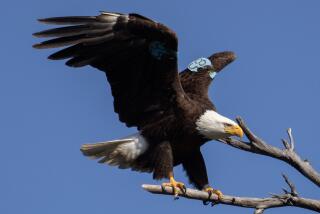BREEDING BIRD: GOLDEN EAGLE (Aquila chrysaetos)
- Share via
Description: This eagle is brown overall with gold wash over back of head and neck and a light band on outer tail feathers. Feet and legs are yellow-gold; tops of legs are covered by feathers. In flight, immatures’ distinctive white banding on tail and white patches at base of primaries are evident. Length: 30-40 inches. Wing Span: 7 feet.
Habitat: Hilly terrain, mountains, foothills and open country.
Diet: Jackrabbits, rodents, birds, reptiles and carrion (when mammals are scarce).
Displays: The golden eagle will spiral upward and nose-dive with wings half open, then glide while diving and calling.
Nest: Sticks, brush and leaves interwoven and lined with fine materials, including aromatic herbs to deter insect pests. Alternatively uses several nests. Perennially returns to nest sites.
Eggs: White to creamy buff with brown markings. Length: 2.9 inches.
Call: Rarely heard, call is a yelping kya ; also whistled notes.
Notes: Long-term pair bonding. During incubation, male captures more food than female and feeds her directly. Male incubates eggs during the day only. Larger sibling often kills smaller sibling. Soars with wings slightly uplifted.
Breeding bird atlas: To report bird breeding activity in your neighborhood, or to get information on the breeding bird atlas, call Sea and Sage Audubon Society members Sylvia Gallagher, (714) 962-8990, or Nancy Kenyon, (714) 786-3160. Note: Map is divided into 5-kilometer squares so that Audubon Society volunteers can more easily survey areas on a regular basis. Sources: Sea and Sage Audubon Society; “The Birder’s Handbook,” Ehrlich, Dobkin and Wheye, Fireside Books (1988); “Field Guide to the Birds of North America,” National Geographic Society (1987); “Birds of Southern California: Status and Distribution,” Garrett and Dunn, Los Angeles Audubon Society (1981). Indicates 5-kilometer-square areas where breeding activity has been confirmed.
More to Read
Sign up for Essential California
The most important California stories and recommendations in your inbox every morning.
You may occasionally receive promotional content from the Los Angeles Times.













